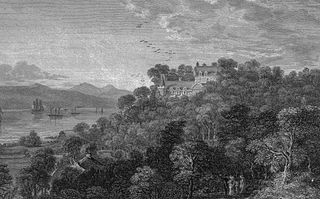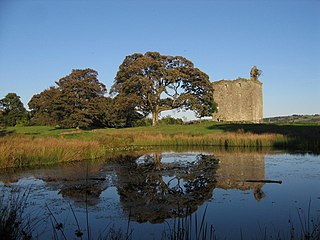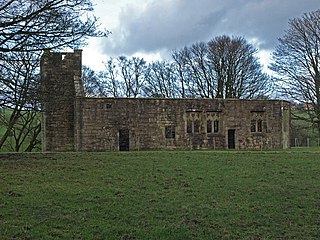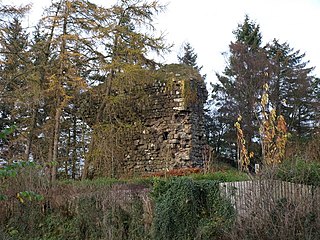

Castle Semple (previously Castletoun) is a former mansion house located in Renfrewshire, Scotland. It is situated near the eastern end of Castle Semple Loch, within Clyde Muirshiel Regional Park.


Castle Semple (previously Castletoun) is a former mansion house located in Renfrewshire, Scotland. It is situated near the eastern end of Castle Semple Loch, within Clyde Muirshiel Regional Park.
Erected, or more probably rebuilt, by John Sempill, 1st Lord Sempill, he changed its name from Castletoun to Castle-Semple. In Willem Blaeu's Atlas Maior , published in 1654, the castle is represented by a mark denoting the largest size of castles. In George Crawford's History of Renfrewshire (1710), he noted, "Upon the brink of the loch stands the castle of Sempill, the principal messuage of a fair lordship of the same denomination, which consists of a large court, part of which seems to be a very ancient building, adorned with pleasant orchards and gardens." According to Gardner, Castleton was built in 1492-3, but Millar states that it was built closer to 1550, as a successor to Elliston Castle.
The estate was sold by Hugh Sempill, 12th Lord Sempill, in 1727, to Colonel William M'Dowall (d. 1748), a younger son of M'Dowall of Garthland. [1] In 1735, M'Dowall demolished the house and erected a new one on its site. The new Castle Semple was an elaborate gothick mansion which became renowned for its extensive gardens which formed the centrepiece of the 900 acres (360 ha) estate. In 1818, M'Dowall sold Castle-Semple to John Harvey, Esquire, of Jamaica. Some workmen repairing drains in 1830 found part of the foundations of the castle still existing below ground. [2]
It burned down in 1924 and the ruins of the central mansion house were demolished in 1960 leaving only the four outbuildings which flanked the central house, two of which were joined by windowed corridors which are still intact. These buildings still remain on the northern end of the loch and include the billiard room, stables, servants quarters, kitchens, coach house, and head groomsmen cottage. These have since been converted into 4 private homes and are now grade B listed buildings. Impressive gate-arches, a walled garden and a small temple folly on a knoll are also remains of the Castle Semple estate. [3] [4]
A copper cannon, having the arms of Scotland, and J.R.S. engraved on it, was found in the loch near the peel. This relique was preserved at Castle Semple. [2]
At one time, Glasgow and Ayr Railway passed through the Castle Semple estate and in the immediate neighbourhood of the loch. [2] Castle Semple had its own railway station which never opened to the general public. [5] A simple platform existed here, used mostly by the workers on the estate. [6] Had the station opened to the public, it would likely have been called Howwood or St Bryde's (after nearby St Bryde's House and burn). [6] The trackbed is now part of National Cycle Route 7.
Lord Semple founded a collegiate church near the lake; a stone in the outer wall of Castle Semple Collegiate Church bears the letters R. L. S., and the arms of Sempill and Montgomery. Eastward of the lake, and on the south side, are the remains of the old tower of Elliston Castle, the residence of the Semple family prior to 1550. [2]
The 'Temple' on Kenmuir Hill by Castle Semple is a Category B listed building. [7]

Lochwinnoch is a village in the council area and historic county of Renfrewshire in the west central Lowlands of Scotland. Lying on the banks of Castle Semple Loch and the River Calder, Lochwinnoch is chiefly a residential dormitory village serving nearby urban centres such as Glasgow and Paisley. Its population in 2001 was 2628.
Howwood is a village in Renfrewshire, Scotland. It is between Johnstone and Lochwinnoch, just off the A737 dual carriageway between the nearby town of Paisley and the Ayrshire border. It is served by Howwood railway station.
Robert Sempill, in all probability a cadet of illegitimate birth of the noble house of Sempill or Semple, was a Scottish ballad-writer and satirist.
Francis Sempill was a Scottish poet, the son of Robert Sempill the younger.

Castle Semple Loch is a 1.5-mile-long (2.5 km) inland freshwater loch at Lochwinnoch in Renfrewshire, Scotland. Originally part of an estate of the same name, it is now administered by Clyde Muirshiel Regional Park as a watersports centre. An RSPB bird sanctuary is located on the loch's southern shore.

Clan Sempill is a Scottish clan of the Scottish Lowlands.

Castle Semple railway station was intended to be a railway station that would have served the village of Howwood, Renfrewshire, Scotland as part of the Dalry and North Johnstone Line on the Glasgow and South Western Railway.

Belltrees Peel is a medieval tower situated on a peninsula in Castle Semple Loch in Renfrewshire, Scotland, on which was once an island.

Clyde Muirshiel Regional Park is the collective name for areas of countryside set aside for conservation and recreation on the South Clyde estuary in Scotland.
Semple is both a surname of Scottish origin, and a given name. Notable people with the name include:

Crosbie Castle and the Fullarton estate lie near Troon in South Ayrshire. The site was the home of the Fullarton family for several centuries. The lands were part of the feudal Barony of Corsbie Fullartoune (sic). The Crosbie Castle ruins were eventually used as an ice house after the new Fullarton House mansion was built. The mansion house was later demolished and the area set aside as a public park and golf course.

Skelmorlie Castle stands on the eastern shore of the Firth of Clyde, Scotland, at the north-western corner of the county of Ayrshire. The structure dates from 1502, and was formerly the seat and stronghold of the Montgomery Clan. The modern village of Skelmorlie lies to the north of the castle.

Barr Castle is a late medieval tower house. It can be seen today as a ruin on a low ridge to the south of the village of Lochwinnoch, Renfrewshire, Scotland.

Castle Semple Collegiate Church is located in Renfrewshire, Scotland. It is situated near the eastern end of Castle Semple Loch, within Clyde Muirshiel Regional Park, and 2 miles (3.2 km) west of Howwood on the B787, then on to the B776. The late Gothic church is under the protection of Historic Environment Scotland as a Scheduled monument.
Robert Sempill, 3rd Lord Sempill was a Scottish lord of Parliament.
Hugh Sempill, 12th Lord Sempill was a Scottish soldier.

The lands of Elliston, previously Elliotston or Eliotstoun or Elliestoun in the Parish of Lochwinnoch were part of the holdings of the Barony of Elliston, later a part of the Castle Semple barony and estates. The ruins of the castle lie a short distance from Howwood in Renfrewshire in a private garden on a minor road between the A737 and the B776. The name may have derived from earlier holders of the lands, however the Sempill family held them since at least 1220. The castle was abandoned circa 1550 when John Sempill, 1st Lord Sempill moved to a new castle at Castleton which he renamed Castle Semple.
The ruins of The Peel of Castle Semple or the Castle Semple Loch Peel Tower, once designated in Scottish Reformation times as the Defender of the Faith lie in Castle Semple Loch, Parish of Lochwinnoch, Renfrewshire, Scotland. The castle stands on a rocky islet which due to drainage works and farming activities has now become linked to the shoreline through a curved earthen embankment. Semple is sometimes written as 'Sempill'; however, for consistency the more commonly found spelling will be used here.

John Semple was a seventeenth century minister in Ulster and Scotland. He began to preach after exhorting the people while leading the psalm-singing. His Presbyterian principles brought him into opposition to the policies of the civil authorities. He refused The Black Oath and was pursued by those sent from Dublin to apprehend non swearers. He relocated to Scotland and was named multiple times and threatened with severe punishment throughout his life including shortly before his death in his 75th year.
John Sempill was a Scottish courtier and husband of Mary Livingston, one of the Four Maries who grew up with Mary, Queen of Scots.